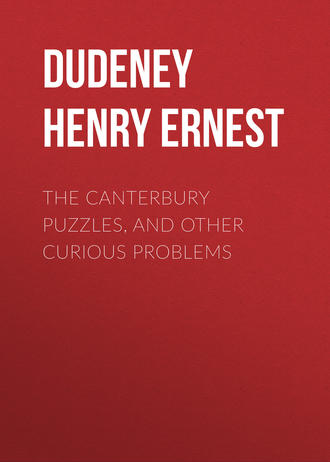 полная версия
полная версияThe Canterbury Puzzles, and Other Curious Problems
99.—The Two Errand Boys
All that is necessary is to add the two distances at which they meet to twice their difference. Thus 720 + 400 + 640 = 1760 yards, or one mile, which is the distance required. Or, put another way, three times the first distance less the second distance will always give the answer, only the first distance should be more than two-thirds of the second.
100.—On the Ramsgate Sands
Just six different rings may be formed without breaking the conditions. Here is one way of effecting the arrangements.
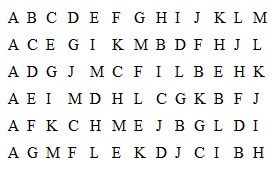
Join the ends and you have the six rings.
Lucas devised a simple mechanical method for obtaining the n rings that may be formed under the conditions by 2n+1 children.
101.—The Three Motor-Cars
The only set of three numbers, of two, three, and five figures respectively, that will fulfil the required conditions is 27 × 594 = 16,038. These three numbers contain all the nine digits and 0, without repetition; the first two numbers multiplied together make the third, and the second is exactly twenty-two times the first. If the numbers might contain one, four, and five figures respectively, there would be many correct answers, such as 3 × 5,694 = 17,082; but it is a curious fact that there is only one answer to the problem as propounded, though it is no easy matter to prove that this is the case.
102.—A Reversible Magic Square
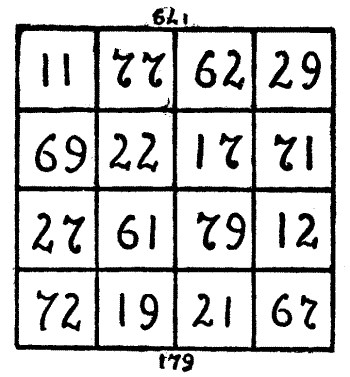
It will be seen that in the arrangement given every number is different, and all the columns, all the rows, and each of the two diagonals, add up 179, whether you turn the page upside down or not. The reader will notice that I have not used the figures 3, 4, 5, 8, or 0.
103.—The Tube Railway
There are 640 different routes. A general formula for puzzles of this kind is not practicable. We have obviously only to consider the variations of route between B and E. Here there are nine sections or "lines," but it is impossible for a train, under the conditions, to traverse more than seven of these lines in any route. In the following table by "directions" is meant the order of stations irrespective of "routes." Thus, the "direction" BCDE gives nine "routes," because there are three ways of getting from B to C, and three ways of getting from D to E. But the "direction" BDCE admits of no variation; therefore yields only one route.

We thus see that there are just 640 different routes in all, which is the correct answer to the puzzle.
104.—The Skipper and the Sea-Serpent
Each of the three pieces was clearly three cables long. But Simon persisted in assuming that the cuts were made transversely, or across, and that therefore the complete length was nine cables. The skipper, however, explained (and the point is quite as veracious as the rest of his yarn) that his cuts were made longitudinally—straight from the tip of the nose to the tip of the tail! The complete length was therefore only three cables, the same as each piece. Simon was not asked the exact length of the serpent, but how long it must have been. It must have been at least three cables long, though it might have been (the skipper's statement apart) anything from that up to nine cables, according to the direction of the cuts.
105.—The Dorcas Society
If there were twelve ladies in all, there would be 132 kisses among the ladies alone, leaving twelve more to be exchanged with the curate—six to be given by him and six to be received. Therefore, of the twelve ladies, six would be his sisters. Consequently, if twelve could do the work in four and a half months, six ladies would do it in twice the time—four and a half months longer—which is the correct answer.
At first sight there might appear to be some ambiguity about the words, "Everybody kissed everybody else, except, of course, the bashful young man himself." Might this not be held to imply that all the ladies immodestly kissed the curate, although they were not (except the sisters) kissed by him in return? No; because, in that case, it would be found that there must have been twelve girls, not one of whom was a sister, which is contrary to the conditions. If, again, it should be held that the sisters might not, according to the wording, have kissed their brother, although he kissed them, I reply that in that case there must have been twelve girls, all of whom must have been his sisters. And the reference to the ladies who might have worked exclusively of the sisters shuts out the possibility of this.
106.—The Adventurous Snail
At the end of seventeen days the snail will have climbed 17 ft., and at the end of its eighteenth day-time task it will be at the top. It instantly begins slipping while sleeping, and will be 2 ft. down the other side at the end of the eighteenth day of twenty-four hours. How long will it take over the remaining 18 ft.? If it slips 2 ft. at night it clearly overcomes the tendency to slip 2 ft. during the daytime, in climbing up. In rowing up a river we have the stream against us, but in coming down it is with us and helps us. If the snail can climb 3 ft. and overcome the tendency to slip 2 ft. in twelve hours' ascent, it could with the same exertion crawl 5 ft. a day on the level. Therefore, in going down, the same exertion carries it 7 ft. in twelve hours—that is, 5 ft. by personal exertion and 2 ft. by slip. This, with the night slip, gives it a descending progress of 9 ft. in the twenty-four hours. It can, therefore, do the remaining 18 ft. in exactly two days, and the whole journey, up and down, will take it exactly twenty days.
107.—The Four Princes
When Montucla, in his edition of Ozanam's Recreations in Mathematics, declared that "No more than three right-angled triangles, equal to each other, can be found in whole numbers, but we may find as many as we choose in fractions," he curiously overlooked the obvious fact that if you give all your sides a common denominator and then cancel that denominator you have the required answer in integers!
Every reader should know that if we take any two numbers, m and n, then m2 + n2, m2 – n2, and 2mn will be the three sides of a rational right-angled triangle. Here m and n are called generating numbers. To form three such triangles of equal area, we use the following simple formula, where m is the greater number:—
mn + m2 + n2 = a m 2 – n2 = b2mn + n2 = cNow, if we form three triangles from the following pairs of generators, a and b, a and c, a and b + c, they will all be of equal area. This is the little problem respecting which Lewis Carroll says in his diary (see his Life and Letters by Collingwood, p. 343), "Sat up last night till 4 a.m., over a tempting problem, sent me from New York, 'to find three equal rational-sided right-angled triangles.' I found two … but could not find three!"
The following is a subtle formula by means of which we may always find a R.A.T. equal in area to any given R.A.T. Let z = hypotenuse, b = base, h = height, a = area of the given triangle; then all we have to do is to form a R.A.T. from the generators z2 and 4a, and give each side the denominator 2z (b2 – h2), and we get the required answer in fractions. If we multiply all three sides of the original triangle by the denominator, we shall get at once a solution in whole numbers.
The answer to our puzzle in smallest possible numbers is as follows:—
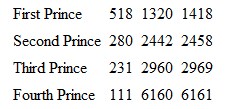
The area in every case is 341,880 square furlongs. I must here refrain from showing fully how I get these figures. I will explain, however, that the first three triangles are obtained, in the manner shown, from the numbers 3 and 4, which give the generators 37, 7; 37, 33; 37, 40. These three pairs of numbers solve the indeterminate equation, a3b – b3a = 341,880. If we can find another pair of values, the thing is done. These values are 56, 55, which generators give the last triangle. The next best answer that I have found is derived from 5 and 6, which give the generators 91, 11; 91, 85; 91, 96. The fourth pair of values is 63, 42.
The reader will understand from what I have written above that there is no limit to the number of rational-sided R.A.T.'s of equal area that may be found in whole numbers.
108.—Plato and the Nines
The following is the simple solution of the three nines puzzle:—
9 + 9——.9To divide 18 by .9 (or nine-tenths) we, of course, multiply by 10 and divide by 9. The result is 20, as required.
109.—Noughts and Crosses
The solution is as follows: Between two players who thoroughly understand the play every game should be drawn. Neither player could ever win except through the blundering of his opponent. If Nought (the first player) takes the centre, Cross must take a corner, or Nought may beat him with certainty. If Nought takes a corner on his first play, Cross must take the centre at once, or again be beaten with certainty. If Nought leads with a side, both players must be very careful to prevent a loss, as there are numerous pitfalls. But Nought may safely lead anything and secure a draw, and he can only win through Cross's blunders.
110.—Ovid's Game
The solution here is: The first player can always win, provided he plays to the centre on his first move. But a good variation of the game is to bar the centre for the first move of the first player. In that case the second player should take the centre at once. This should always end in a draw, but to ensure it the first player must play to two adjoining corners (such as 1 and 3) on his first and second moves. The game then requires great care on both sides.
111.—The Farmer's Oxen
Sir Isaac Newton has shown us, in his Universal Arithmetic, that we may divide the bullocks in each case in two parts—one part to eat the increase, and the other the accumulated grass. The first will vary directly as the size of the field, and will not depend on the time; the second part will also vary directly as the size of the field, and in addition inversely with the time. We find from the farmer's statements that 6 bullocks keep down the growth in a 10-acre field, and 6 bullocks eat the grass on 10 acres in 16 weeks. Therefore, if 6 bullocks keep down the growth on 10 acres, 24 will keep down the growth on 40 acres.
Again, we find that if 6 bullocks eat the accumulated grass on 10 acres in 16 weeks, then
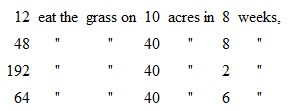
Add the two results together (24 + 64), and we find that 88 oxen may be fed on a 40-acre meadow for 6 weeks, the grass growing regularly all the time.
112.—The Great Grangemoor Mystery
We were told that the bullet that killed Mr. Stanton Mowbray struck the very centre of the clock face and instantly welded together the hour, minute, and second hands, so that all revolved in one piece. The puzzle was to tell from the fixed relative positions of the three hands the exact time when the pistol was fired.
We were also told, and the illustration of the clock face bore out the statement, that the hour and minute hands were exactly twenty divisions apart, "the third of the circumference of the dial." Now, there are eleven times in twelve hours when the hour hand is exactly twenty divisions ahead of the minute hand, and eleven times when the minute hand is exactly twenty divisions ahead of the hour hand. The illustration showed that we had only to consider the former case. If we start at four o'clock, and keep on adding 1 h. 5 m. 27-3/11 sec., we shall get all these eleven times, the last being 2 h. 54 min. 32-8/11 sec. Another addition brings us back to four o'clock. If we now examine the clock face, we shall find that the seconds hand is nearly twenty-two divisions behind the minute hand, and if we look at all our eleven times we shall find that only in the last case given above is the seconds hand at this distance. Therefore the shot must have been fired at 2 h. 54 min. 32-8/11 sec. exactly, or, put the other way, at 5 min. 27-3/11 sec. to three o'clock. This is the correct and only possible answer to the puzzle.
113.—Cutting a Wood Block
Though the cubic contents are sufficient for twenty-five pieces, only twenty-four can actually be cut from the block. First reduce the length of the block by half an inch. The smaller piece cut off constitutes the portion that cannot be used. Cut the larger piece into three slabs, each one and a quarter inch thick, and it will be found that eight blocks may easily be cut out of each slab without any further waste.
114.—The Tramps and the Biscuits
The smallest number of biscuits must have been 1021, from which it is evident that they were of that miniature description that finds favour in the nursery. The general solution is that for n men the number must be m (nn+1) – (n – 1), where m is any integer. Each man will receive m (n – 1)n – 1 biscuits at the final division, though in the case of two men, when m = 1, the final distribution only benefits the dog. Of course, in every case each man steals an nth of the number of biscuits, after giving the odd one to the dog.
1
See footnote on page 198.
2
Mr. Oscar Hoppe, of New York, informs me that, after reading my statement in the Introduction, he was led to investigate the case of n = 19, and after long and tedious work he succeeded in proving the number to be a prime. He submitted his proof to the London Mathematical Society, and a specially appointed committee of that body accepted the proof as final and conclusive. He refers me to the Proceedings of the Society for 14th February 1918.



